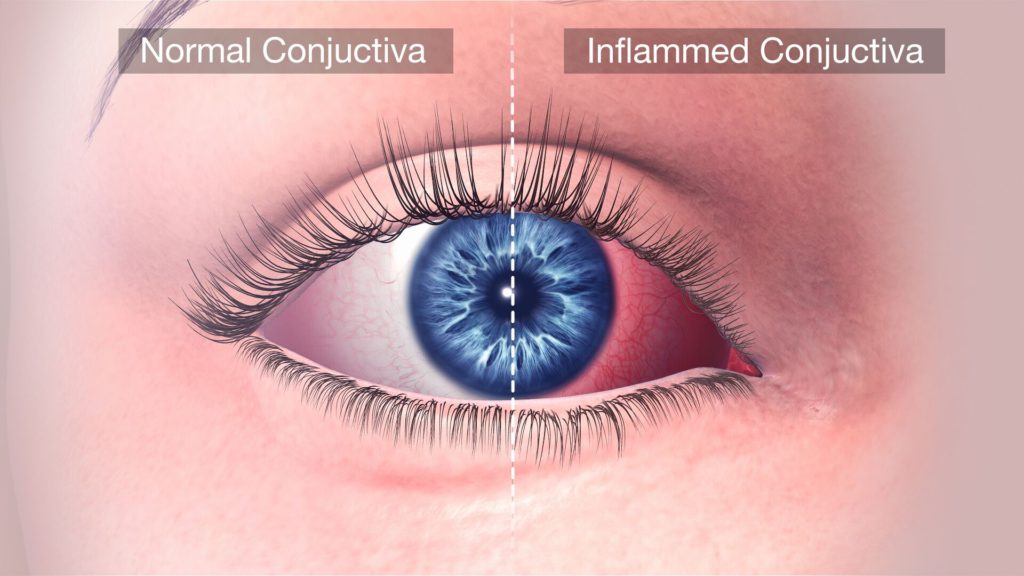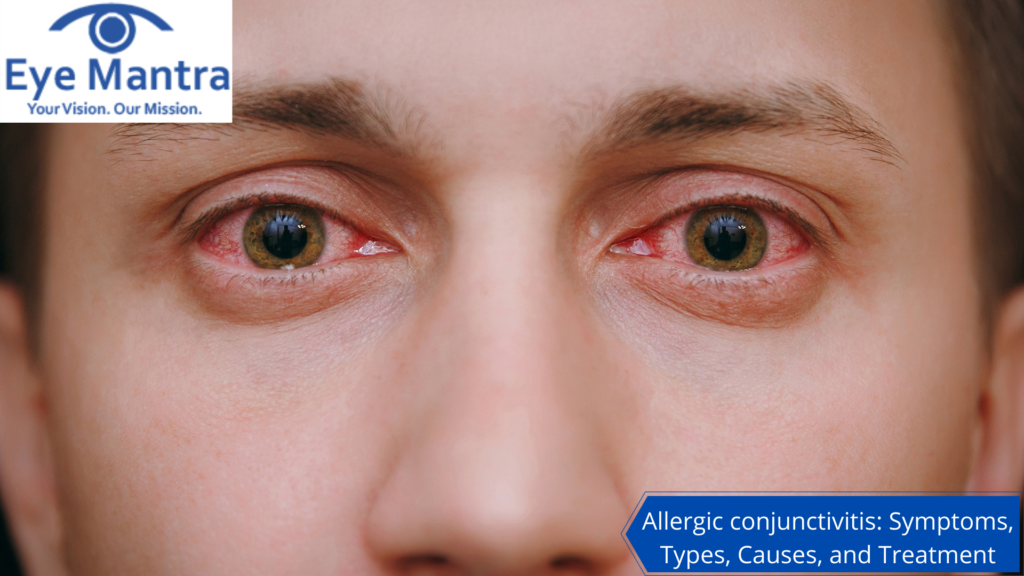Contents
What Is Allergic Conjunctivitis?

Allergic conjunctivitis usually happens when a person’s eyes make contact with an allergen, a substance that makes the body’s system overreact.
The eye becomes sore and inflamed. Symptoms occur because the overreacting system makes the body release histamine and other active substances through mast cells. The blood vessels dilate or expand, and this irritates the nerve endings. The result is an increased secretion of tears.
Symptoms of Allergic Conjunctivitis

Contact conjunctivitis and giant papillary conjunctivitis aren’t seasonal, and symptoms may occur at any time of year. Symptoms of allergic conjunctivitis include:
- Red or pink eyes: The eyes become irritated because the capillaries, or small blood vessels, widen within the conjunctiva.
- Pain: This may affect one or both eyes. If an individual has painful, red eyes, is sensitive to light, and their vision is affected, they must see a doctor immediately.
- Itchiness: As the eyes are irritated, they may itch. Rubbing can make the itchiness worse.
- Swollen eyelids: The eyelids may brag when the conjunctiva becomes inflamed, or if the person has been rubbing them a lot.
- Soreness: The inflammation may make the entire area feel sore and tender. Some people say the soreness feels like burning.
- If the eyelids are red, cracked, or dry, this might indicate contact conjunctivitis.
Causes of Allergic Conjunctivitis
An allergic reaction happens when the immune system overreacts to a substance. Most people do not react in this way to dust, pollen, and other substances, but some are more susceptible.
The following allergens commonly cause allergic conjunctivitis:
• Animal Fur
• Eye Drops Reaction
• Make-up (or any eye makeup)
• Dust Mites.
Types of Allergic Conjunctivitis
There are different types of allergic conjunctivitis:
Seasonal Allergic Conjunctivitis or Allergic Rhino Conjunctivitis
Pollen is that the commonest allergen to cause conjunctivitis in countries that have cold winters. If conjunctivitis results from pollen, there’ll likely be other symptoms, including sneezing, an itchy, blocked, or runny nose, and itchy and watery eyes.
Seasonal allergic conjunctivitis or allergic rhinoconjunctivitis is additionally referred to as pollinosis. It usually happens during the spring and summer months. At this time, plants, and especially grass, trees, and flowers, are in pollen. Some people have symptoms during early fall.
Contact Conjunctivitis
It is also concerned to as contact keratoconjunctivitis, symptoms are usually caused by cosmetics, eye drops, or other chemicals that irritate the conjunctiva in those that are susceptible. Contact with these substances leads to an allergic response. Some people are sensitive to specific substances.
Giant Papillary Conjunctivitis
This often results from wearing contact lenses. In some people, contact lenses cause discomfort. This can get progressively worse and increasingly uncomfortable, causing the eyes to become red. Giant papillary conjunctivitis (GPC) can also occur when an individual uses hard contact lenses after eye surgery. Poor hygiene when handling contact lenses, solutions, and cases may contribute to infections of the eye.
Perennial Conjunctivitis
Perennial conjunctivitis lasts all year. It mainly results from an allergy to deal with dust mites. These are microscopic insect-like creatures that live mainly in bedding, upholstered furniture, and carpets. Dust mites eat skin cells shed by people.
Dust-mite allergy is an immune-system response to a selected dust mite protein. This causes a range of problems, including conjunctivitis, a blocked or runny nose, sneezing, and contraction of the airways, as in asthma.
Naphazoline could also be a decongestant that can treat redness caused by allergies and minor irritation. Products containing naphazoline are available for purchase online.
Tetrahydrozoline, which is found in drops like Visine. Tetrahydrozoline could also be a decongestant that, like naphazoline, clears redness caused by allergy, exhaustion, and irritation.
Eye lubricant drops. Numerous drops are available, most of which use lipids to mimic real tears. There’s some debate among eye doctors about whether preservatives in some eye drops are safe. Preservative-free drops are available. Eye lubricant drops are available for purchase online.
A doctor might prescribe:
Glaucoma drops to scale back pressure within the eyes
Antibiotic drops or ointments to treat infection within the eyes
Prescription artificial tears, which may increase moisture within the eyes and reduce irritation
Other causes include the tiny scales from animal skins or hair or bird feathers. These can cause an allergic reaction in some people.
Treatment of Allergic Conjunctivitis

• Avoiding Allergen: Keeping the house clean is a must to keep the allergens at bay. Minimizing soft furnishings and staying indoors when the pollen count is high. If you live in a polluted city, don’t go out unnecessarily and also use eye protection while stepping out.
• Artificial Tears: These eye drops dilute the allergen and help remove it. There are many eye drops available in the market, ensure you use them prescribed by a doctor for maximum effectiveness. check the expiry date before any eye drops to avoid any complications.
• Avoiding Contact Lenses: These should not be used until symptoms have completely disappeared. After using any therapy on the eye, wait 24 hours after treatment has been ended before wearing contact lenses.
• Refraining From Rubbing The Eyes: Rubbing can make the inflammation worse. This can be difficult, as it is tempting to rub itchy eyes, but rubbing can make the inflammation worse. If you’re feeling itchy, use eye drops or wash your eyes with clean water.
• Cold Compresses: Holding a wad of cotton wool soaked in cold water on the eyelid can soothe the eyes. It may be helpful in reducing inflammation.
Drug treatment includes antihistamines, mast cell stabilizers, and occasionally, corticosteroids. Drugs are prescribed on the basis of the severity of the allergy.
Who Should Avoid Eye Drops?
Redness-relieving drops aren’t safe for everybody. People with glaucoma should avoid over-the-counter remedies since some eye drops can increase pressure within the eye. Women who are pregnant or breastfeeding should ask their doctors before using any eye remedy.
When To See A Doctor?
People don’t need to see a doctor whenever their eyes are red. However, anyone who experiences any of the next symptoms will need medical treatment:
- Redness and blurry vision
- Redness and intense pain and itching
- Green or yellow discharge from the eyes
- Difficulty seeing
- Feelings of pressure within the eyes
- Chronically Dry, Itchy eyes
Eye Drops for Allergic Conjunctivitis are Better Resolution. There are pharmacy shops selling eye drops for allergies in India. Ayurvedic allergic eye drops make a big difference to an allergic eye. The success rate is undeniably very high after you begin using anti-allergic eye drops. Eye Mantra eye drops are Ayurvedic eye drops that contain the goodness of 12 natural ingredients. They are safe to use and helps in treatment in an efficient way.
And you would like to be reminded that just in case the itchiness in your eyes persists, the primary thing you would like to try to do is to consult your ophthalmologist.
For any eye-associated problem, visit our hospital in Delhi now!
To know more about it, you can easily visit our website Eyemantra. If you are looking for other services like cataract surgery, Retina surgery or Ocuploplasty you can simply ring at +91-9711115191. Even you can simply mail us on [email protected].



